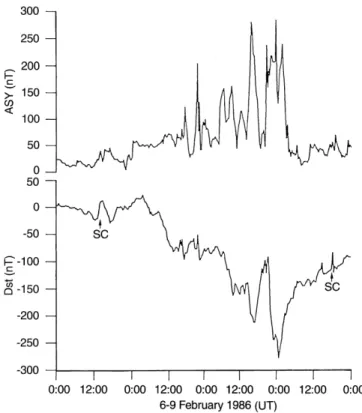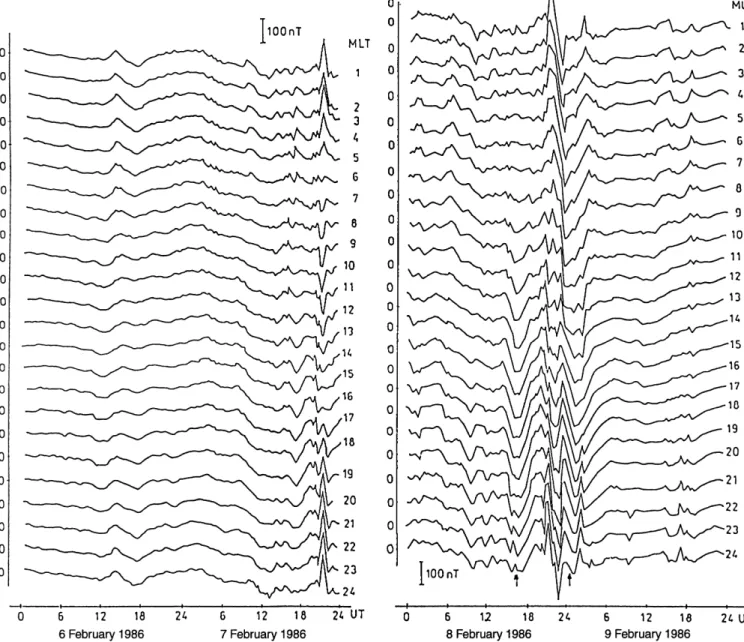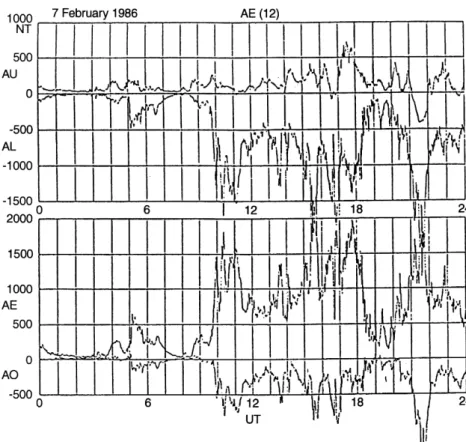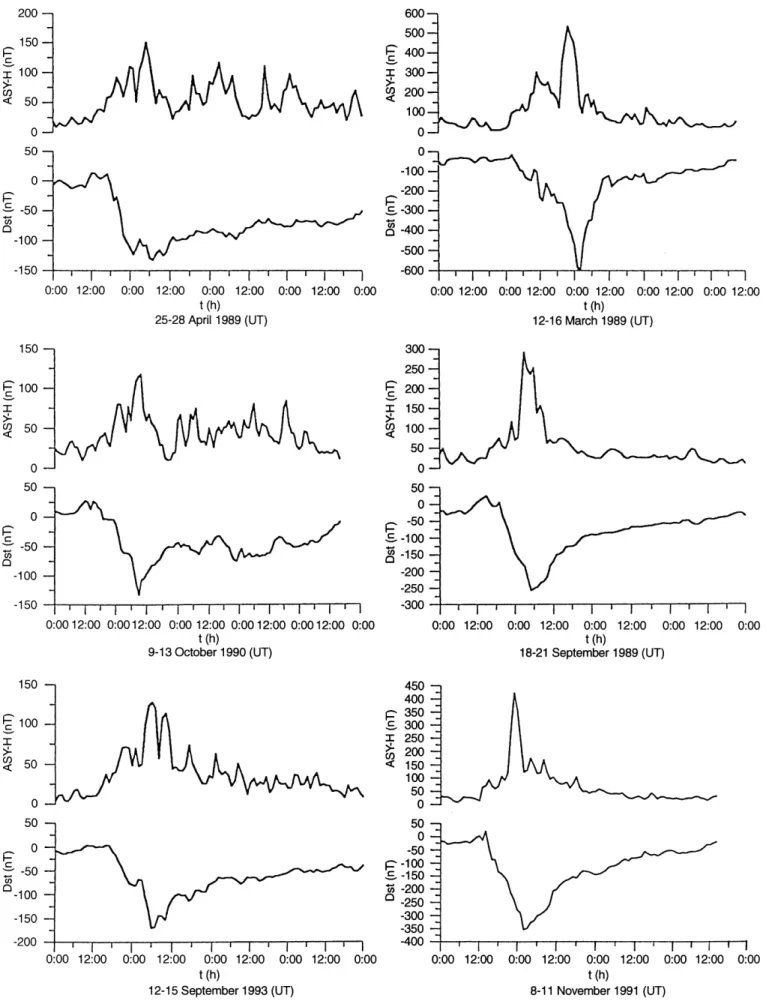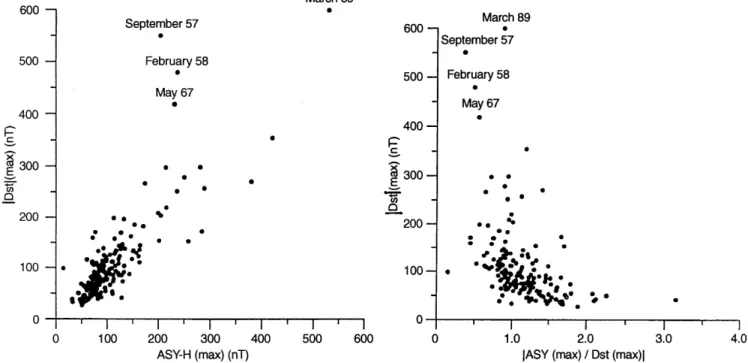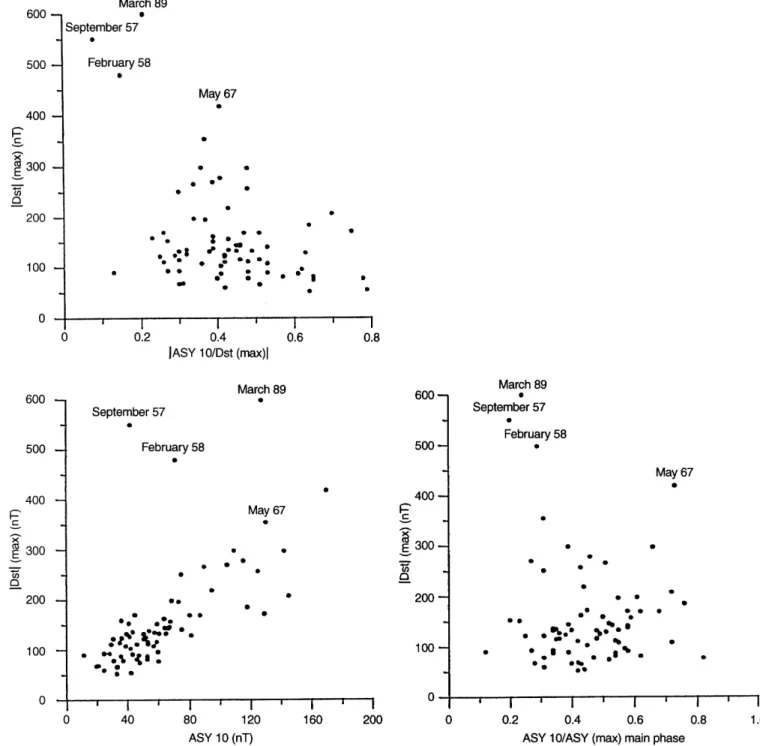HAL Id: hal-00316488
https://hal.archives-ouvertes.fr/hal-00316488
Submitted on 1 Jan 1999
HAL is a multi-disciplinary open access
archive for the deposit and dissemination of sci-entific research documents, whether they are pub-lished or not. The documents may come from teaching and research institutions in France or abroad, or from public or private research centers.
L’archive ouverte pluridisciplinaire HAL, est destinée au dépôt et à la diffusion de documents scientifiques de niveau recherche, publiés ou non, émanant des établissements d’enseignement et de recherche français ou étrangers, des laboratoires publics ou privés.
A. Grafe
To cite this version:
A. Grafe. Are our ideas about Dst correct?. Annales Geophysicae, European Geosciences Union, 1999, 17 (1), pp.1-10. �hal-00316488�
Are our ideas about Dst correct?
A. GrafeGeoForschungsZentrum Potsdam, Telegrafenberg, D-14473 Potsdam, Germany Received: 10 February 1998 / Revised: 11 May 1998 / Accepted: 2 June 1998
Abstract. The idea of two separate storm time ring currents, a symmetric and an asymmetric one has accepted since the 1960s. The existence of a symmetric equatorial ring current was concluded from Dst. How-ever, the asymmetric development of the low-latitude geomagnetic disturbance ®eld during storms lead to the assumption of the real existence of an asymmetric ring current. I think it is time to inquire whether this conception is correct. Thus, I have investigated the development of the low-latitude geomagnetic ®eld dur-ing all the magnetic local times under disturbed and quiet conditions. The storm on February 6±9, 1986 and a statistical analysis of many storms has shown that the asymmetry does not vanish during the storm recovery phase. The ratio between the recovery phase asymmetry and the main phase asymmetry is low only for powerful storms. Storms of moderate intensity show the opposite. The global picture of the ®eld evolution of the February storm shows clear dierences at dierent local times. For instance the main phase and recovery phase start time does not coincide with Dst. Also the ring current decay is not the same at dierent local times. Therefore, Dst gives an incorrect picture of the ®eld development. Moreover, asymmetry does not disappear during inter-national quiet days as the investigation of the low-latitude geomagnetic ®eld shows. Considering all these observations, I think we must revise our ideas about the ring current. In my opinion only one ring current exists and this is an asymmetric one. This asymmetry increases during storms and develops rather fast to more or less symmetric conditions. However, in no case is it justi®ed to conclude from Dst that a symmetric ring current exists.
Key words. Magnetospheric physics (current systems; magnetospheric con®guration and dynamics; storms and substorms).
Introduction
The idea of two separate storm time ring currents, a symmetric and an asymmetric one has been accepted since the 1960s. The evidence for existence of a symmetric equatorial ring current was concluded from Dst. The birth of the term storm time variation goes back to the work of Moos (1910). Later Chapman (1919) called this variation Dst. The ®rst activity indices of Dst were developed by Vestine et al. (1947) long before Sugiura (1964) published his Dst indices which have been used since then for the description of the storm time variation. As a result of the calculation of Dst as the ®rst term of the Fourier analysis of the geomagnetic ®eld Dst is only a function of the time and the dipole latitude and not of the dipole longitude. It is always important to establish again that Dst is only a mathematical parameter obtained by analysing the geomagnetic ®eld observations and nothing more. Its physical meaning is not obvious. The result of this analysis does say anything about the external sources of Dst. However, in the past some magnetospheric sources were proposed which can generate a symmetric magnetic ®eld on the Earth's surface. Such sources are the magnetospheric current systems e.g. Chapman-Ferraro-current, symmetric equatorial ring Chapman-Ferraro-current, ®eld aligned currents, ionospheric currents, and tail current (Yacob, 1966, Campbell, 1973; Sun et al., 1984; Fuller-Rowell et al., 1994, Campbell, 1996, 1997). Supported by the discovery of the Van Allen radiation belts and other satellite observations (Frank, 1967) it is today generally accepted that Dst is mainly caused by a symmetric ring current. This is in contrast to a present increasing of discussion about the in¯uence of the tail current on Dst (Alexeev et al., 1996). However, Dst is only one component of the observed ground-based geomagnetic ®eld. In principle the geomagnetic ®eld is asymmetric at all latitudes on Earth. Chapman (1919) called this longitudinal inequality, the asymmetric deviations of the
disturbance ®eld from Dst, the DS variation. More recently Akasofu and Chapman (1964) supposed an asymmetric ion charged particle distribution in the ring current region as the cause of the DS variation in low latitudes. They assumed a separate ¯owing partial ring current which was con®rmed by satellite observations discussed by Cahill (1966). Thereby, the idea of two independently occurring ring currents the symmetric and the asymmetric one was born. Later many papers were published about a symmetric and an asymmetric ring current (Cummings 1966; Grafe, 1968; Kamide and Fukushima, 1971; Crooker and McPherron, 1972; Fukushima and Kamide, 1973; Siscoe and Crooker, 1974; Williams, 1981). Lui et al. (1987) investigating direct satellite observations could show that the ring current has a ®ne structure pointing to many separated small asymmetric ring currents.
Today the existence of a symmetric and an asym-metric ring current is a ®xed part of our knowledge about the processes in the inner magnetosphere. How-ever, do we have clear evidence that our conception is right? I think we have no evidence. Why do we conclude the existence of a symmetric ring current from the calculated Dst variation? I could never understand this conclusion. This conclusion was drawn before know-ledge about the population of the ring current particles in the inner magnetosphere was available. This popula-tion is more or less asymmetric as satellite observapopula-tions show. Doubtless the asymmetry of the low-latitude magnetic ®eld increases strongly during the storm main phase and decreases during the storm recovery phase. However, there are two fundamental questions:
1. How does the asymmetry of the low-latitude geo-magnetic ®eld develop during the geo-magnetic storm phases and how is it related to the magnetic storm intensity?
2. Is the low-latitude geomagnetic ®eld also asymmetric during quiet conditions? In the following investiga-tion I want to try to answer these quesinvestiga-tions.
Asymmetry of the low-latitude geomagnetic ®eld during storm main and recovery phase
The great geomagnetic storm on February 06±09, 1986 Magnetic ®eld data of nine low-latitude geomagnetic observatories were used to estimate Dst and the asymmetry index ASY (Kawasaki and Akasofu, 1971). The position of observatories are shown in Table 1. The geomagnetic latitude of these observatories is about from 20 to 35°. The mean of the geomagnetic latitude of these observatories is 28.5°. The deviation of latitude for each station from this mean value gives a certain inaccuracy of the estimation of Dst and ASY. However, it is more important to have a sucient longitudinal separation of the observatories. This requirement is full®lled as Table 1 shows. The horizontal components of the geomagnetic disturbance ®eld (Sq eliminated) were converted into the geomagnetic oriented ®eld
components for all stations. The result of this extensive analysis is shown in Fig. 1. It is important to emphasize that jDstj reaches here only a value <300 nT whereas the Dst index of Sugiura (1964) reaches )312 nT. This eect is caused by the fact that the calculated Dst is valid for low latitudes, but not for the geomagnetic equator. This storm is characterized by a very long main phase of about two days as well as by a complex development. At least three steps of increasing jDstj could be registrated considering the main phase. The last one is the largest. The asymmetry of the disturbance ®eld is strongly variable during the whole main phase. The intensity of ASY is similar to Dst during the last two steps. At the beginning of the recovery phase ASY decreases very quickly. This agrees with the opinion of Akasofu and Chapman (1972a). The method described by Grafe et al.
Table 1. Positions of observatories
Observatories Geographic Geomagnetic latitude longitude latitude longitude San Juan 18.1 293.9 29.4 4.6 M'Bour 14.4 343.0 20.9 56.4 Tenerife 28.5 343.7 34.6 60.0 Pendeli 38.0 23.9 36.3 102.8 Kakioka 36.2 140.2 26.3 207.3 Hatizyo 33.1 139.8 23.2 207.3 Memambetsu 43.9 144.2 34.3 209.7 Honolulu 21.3 202.0 21.4 268.0 Teoloyucan 19.8 260.8 29.5 328.6
Fig. 1. Variation of Dst in low latitudes and the asymmetry of the low-latitude geomagnetic ®eld (ASY) of the storm on February 06±09, 1986
(1996) to estimate the evolution of the storm time magnetic ®eld in low latitudes at all magnetic local times (MLT) was used for further analysis of this storm. This means a global picture of the ground based geomagnetic ®eld was estimated for storm time moments (in UT). The result is depicted in Fig. 2. In principle, Fig. 2 shows a more complex geomagnetic ®eld variation in the afternoon/evening sector than in the morning sector. During the end of the ®rst step of the main phase at about 2100 UT on February 7 a positive variation occurs in the midnight sector and a negative one in the noon sector. The value of ASY is high at this time. Here we have an example of an anomalous DS variation which is not typical for the storm main phase. The anomalous DS variation was described by Grafe (1974). The cause of such a anomalous low-latitude magnetic ®eld asymmetry is not quite clear. Does the ring current asymmetry show an anomalous behavior or increase
suddenly during the main phase of the Chapman-Ferraro current? Unfortunately we can not prove the latter because of missing solar wind data at this time. However, this variation can be possibly also caused by the substorm system. Indeed there is a strong substorm event occurring at about 2100 UT, as the auroral electrojet indices in Fig. 3 show. However, the question is why are no low latitude in¯uences discernible on the strong substorms which occurred at 1015 and at 1530 UT of the same day. Therefore, I am sure that this anomalous DS variation is not caused by the substorm current system.
More important for the discussion here is the evolution of the magnetic ®eld during the second and third step of the main phase. The most active phase of the second step appears essentially in the afternoon/ evening sector. No decrease of the geomagnetic hori-zontal component occurs during the morning hours. The
Fig. 2. Storm time variation of the geomagnetic ®el in low latitudes at dierent local times of the storm on February 06±09, 1986 ("=beginning of the Dst recovery phase)
third and strongest step of the main phase is character-ized by magnetic ®eld disturbances at all local times. Once again, these are most turbulent in the afternoon/ evening sector. Whereas the development in the morning sector is more or less in accordance with Dst (Fig. 1) we recognize clearly two separate decreases of the magnetic ®eld in the evening sector (caused by consecutive increases of the ring current intensity). The arrows in Fig. 2 show the beginning of Dst recovery. We empha-size a considerable deviation at the beginning of the recovery phases in the evening sector from that in Dst. The decay of the ®rst recovery phase is very fast in this sector. This is caused by the wave-particle interaction process found by Grafe et al. (1996). Also very remark-able is the fact that the second step of the main phase as well as the third step at ®rst starts in the afternoon sector at about 1700/1800 MLT. Therefore, Fig. 2 supplies a very informative picture about the global development of the storm magnetic ®eld. For instance it is logical to conclude that during the second step the energy injection of the tail was too weak to reach the whole surrounding Earth region. The injected particles were stopped in the noon sector. This also causes a high asymmetry during the recovery phase. For the third step the energy of the injection was very high. Therefore, the whole surround-ing Earth region was in¯uenced. As Fig. 2 shows, the last recovery phase of this storm ran very similarly at all MLT. This means that for strong storms the asymmetry is reduced very quickly at the beginning of the recovery phase. Considering all the informations about the global evolution of the geomagnetic storm ®eld in Fig. 2 we should ask whether Dst supplies us with information
which is correct. Concerning the beginning of the recovery phase Dst provides a totally wrong picture. The recovery phase starts dierently at dierent local times. Therefore, we have to ask whether any reasons exist to assume that in addition to an asymmetric ring current also a symmetric one acts during the storm. Keeping information from Fig. 2 in mind nothing appears to suggest this. The storm of February 06±09 is a favorable example to show that during moderately strong disturbances, contrary to strong disturbances, during a storm the asymmetry pending the recovery phase does not vanish. This was also an important result of the paper of Grafe et al. (1996). In this paper ASY was investigated during the recovery phase for storms of dierent intensity. The storms of moderately strong intensity do not show any disappearance of asymmetry. Figure 4 shows this fact very impressively. On the left side there are three storms of moderate intensity. For these storms the ratio of ASY (recovery phase)/ASY (main phase) is higher than for the strong storms on the right side. However, it is very important that the asymmetry does not vanish during the recovery phase. Independent of the intensity of the storm this asymmetry has values between 50 and 100 nT.
Statistical results
The goal of this section is to ®nd the relationships between Dst and ASY during main and recovery phase for storms of dierent activity. Dst and ASY from 1989± 1995 and of some very powerful storms (September
Fig. 3. Aurol electrojet indices of February 07, 1986
Fig. 4. Some examples of the variation of Dst and ASY for moderate (left side) and strong (right side) storms
1957, February 1958, May 1967) were used to investi-gate these relationships. Figure 5 shows some of these relationships. On the left hand side the relationship between the maximum value of jDstj and maximum of ASY during the storm main phase if represented. The well-known eect that the asymmetry increases when the absolute value of Dst increases is clearly shown by Fig. 5. However, because this positive correlation is caused by the very strong storms it is not linear. Taking into account a linear relationship between jDst maxj and ASY(max) the asymmetry for very strong storms is lower than expected. This is depicted also on the right hand side of Fig. 5. The ratio between ASY(max) and Dst(max) decreases with increasing jDstj.
Figure 6 shows the relationship between the asym-metry during the recovery phase and the jDstj during the main phase using again the maximum value of Dst . The ASY mean value for 10 h after the beginning of the recovery phase was taken as a characteristic value of the asymmetry during the recovery phase. The upper representation clearly shows that the asymmetry also increases with increasing storm intensity during the recovery phase but the linearity of this relationship is violated for very strong storms. This corresponds to the conception that the storm time magnetic ®eld symmetry is reached more or less at the end of the main phase when considering very strong storms. However for moderate storms symmetry is not reached at the end of the main phase.
The relationship between the ratio of the asymmetry during the recovery phase to maximum jDstj during the main phase and the intensity of the storm is shown on the left hand side of the lower part of Fig. 6. Notwith-standing the relatively high scattering of this ratio for
weak storms it can be clearly seen that this ratio is low for very strong storms. Therefore, the asymmetry during the recovery phase is slightly higher for moderate storms than for strong storms. This statistical result is in a good accordance with the result of the special storm on February 06±09, 1986. In Fig. 6 on the right hand side of the lower part, the relationship is represented between the ratio of the asymmetry during recovery and main phase and the intensity of the storm. This ratio was higher than 0.5 for some storms, but was only <0.3 for the three strongest storms. However, this representation also shows that for all investigated storms the asymme-try was never 0.
Asymmetry of the low latitude geomagnetic ®eld during quiet conditions
There are rarely publications which describe the condi-tion of the quiet time low-latitude geomagnetic ®eld in connection with the ring current. However, it is certain that the ring current does not vanish completely during quiet conditions. Schmidt (1921) has assumed a ``null-level'' of the ring current which is the sum of all none-terminated ring current recovery phases. On the basis of the magnetic observations of Potsdam from 1892±1910 (1921) Schmidt found a value for the ring current null-level of about 160 nT. Today this null-null-level is called quiet-time ring current. It is generally assumed that this is a symmetric ring current. However, none of the best known literature which describes magnetospheric pro-cesses mentions the quiet-time ring current (see e.g., Carovillano et al. 1968; Akasofu and Chapman 1972; Jacobs 1991).
Fig. 5. Relationship between maximum jDstj and ASY and maximum jDstj and jASY =Dstj during the storm maim phase (1989±1995 and some very strong storms)
The question that whether the quiet-time ring current is symmetric or asymmetric is of fundamental impor-tance. Therefore, I shall try to answer this question, in the following part. In order to do this I have used the indices Dst, ASY and AL for four international quiet days of 1990. All these indices were supplied from the World Data Center C2 for Geomagnetism of the Kyoto University. The variation of the hourly mean values of these indices is represented in Fig. 7. The observation that the ®eld asymmetry is often greater than Dst is an essential conclusion from Fig. 7. Sometimes ASY reach-es 40 nT or more (on February 13, 1990). Also when Dst
is about zero ASY can reach 30 nT (on March 17, 1990 and October 08, 1990). This means that the low-latitude magnetic ®eld asymmetry does not vanish during quiet conditions. As it is also shown by Fig. 7 that the asymmetry on these four quiet days cannot be caused by a substorm current system because AL is very low.
However, we have to ask further: is it possible that this asymmetry can be actually caused by an asymmetric ring current or is another explanation imaginable? We can give a clear answer in Fig. 8 where local time pro®les of the averaged ASY values are shown repre-senting ®ve international quiet days of February 1990.
Fig. 6. Relationship between maximum jDstj and the over 10 h averaged values of ASY after beginning of the recovery phase (1989±1995 and some very strong storms)
These data were measured at the observatories listed in Table 2. To estimate the DS1 variation the observation points were balanced using the method of least squares at all UT. The observations are in a good correspon-dence with the calculated DS1 variation. The minimum of DS1 always appears in the evening sector. This is a clear feature of an asymmetric ring current and cannot be explained by another cause. Therefore we have to assume that the quiet-time ring current is always an asymmetric one.
Discussion
The observations of the Satellite OGO3 (Frank, 1970) have shown that the observed asymmetry of the low-latitude geomagnetic ®eld during the storm main phase can be explained by an asymmetric distribution of the trapped ions in the inner magnetosphere. Thus the appearance of the maximum ion density was observed in the evening sector. This maximum is also in accordance with the observed maximum of the geomagnetic ®eld decrease occurring in the same sector. Thus the existence of an asymmetric ring current during the storm main phase was established by these OGO3 observations. However, do any of these observations contain clear evidence entitling us to assume that there also is a symmetric ring current operating independently from
the asymmetric one? I think these observations do not allow us to conclude from Dst that a symmetric ring current exists. The investigation of the ground-based low-latitude geomagnetic ®eld has yielded following results.
1. The storm time geomagnetic ®eld develops very dierently at dierent local times.
2. There are dierences between storms of dierent intensity concerning the entry of ring current particles into the Earth's environment. During strong storms the ring current energy is obviously high enough to quickly reach all regions surrounding the Earth. With weaker storms, the energy is not so high, and therefore this energy will be stopped in the evening/ afternoon sector. Moreover, the high main phase asymmetry vanishes very quickly for strong storms and reaches already typical recovery phase asymmet-rics at the beginning of the recovery phase.
3. The asymmetry during the recovery phase is never zero. The values are between 50 and 100 nT.
4. During quiet magnetospheric conditions the local time geomagnetic ®eld asymmetry is not zero in low latitudes. It reaches an average of 30±40 nT. In some cases it can even exceed 50 nT. The minimum value of the geomagnetic horizontal component always ap-pears in the evening sector. This is evidence that the asymmetry is caused by an asymmetric ring current.
Therefore, we conclude that the ring current is also asymmetric during quiet conditions.
Taking into account all these results I can draw the following picture: the trapped particle population in the inner magnetosphere has an asymmetric distribution in
the local time. This is also valid during a quiet magnetosphere. The eect of this asymmetric popula-tion is an asymmetric ring current. There is no evidence for a symmetric particle population and a symmetric ring current during quiet conditions. During the storm main phase the asymmetry increases and very strongly for the strongest storms. However, this strong asymme-try vanishes very quickly, and this ``storm time asym-metry'' has mostly disappeared by the beginning of the storm recovery phase. Again ``quiet time asymmetry'' conditions are reached. At no time is the ring current symmetric. Therefore, the most important conclusion I can draw from this investigation is: in contradiction to the generally valid opinion of two separated ring currents, a symmetric and an asymmetric one, in my opinion exists only an asymmetric ring current in the
Fig. 8. Averaged local time pro®les of ASY calculated from the ®ve international quiet days of February, 1990 (DXg, geomagnetic north component, DYg, geomagnetic east component, H, Honolulu, S, San Juan, A, Ashchabad, L, Lunping)
Table 2.
Observatories Geographic Geomagnetic latitude longitude latitude longitude San Juan 18.1 293.9 29.4 4.6 Ashchabad 38.0 58.1 30.4 134.3 Lunping 25.0 121.2 13.9 190.7 Honolulu 21.3 202.0 21.4 268.0
inner magnetosphere. This ring current changes its degree of asymmetry and shifts its current maximum from the inner boundary of the plasma sheet towards the Earth during disturbed conditions. However, what is then the meaning of Dst? Dst is only a mathematical parameter and does not represent an index of a symmetric ring current. Certainly, Dst has its impor-tance as an useful index characterizing the middle course of geomagnetic storms.
Acknowledgements. Topical Editor K.-H. Glassmeie thanks W. H. Campbell and another referee for their help in evaluating this paper.
References
Akasofu, S. I., and S. Chapman, On the asymmetric development of magnetic storm ®elds in low and middle latitudes, Planet. Space Sci., 12, 607, 1964.
Akasofu, S.-I., and S. Chapman., Solar-terrestrial physics, 1972, Oxford University Press.
Alexeev, I. I., E. S. Belenkaya, V. V. Kalegaev, Y. I. Feldstein, and A. Grafe., Magnetic storms and magnetotail currents, J. Geophys. Res., 101, 7737, 1996.
Cahill, L. J. Jr., In¯ation of the inner magnetosphere during a magnetic storm, J. Geophys. Res., 71, 4505, 1966.
Campbell, W. H., Field levels near midnight at low and equatorial geomagnetic stations, J. Atmos. Terr. Phys., 35, 1127, 1973. Campbell, W. H., Geomagnetic storms, the Dst ring-current myth,
and lognormal distributions, J. Atmos. Terr. Phys., 58, 1171, 1996.
Campbell, W. H., Introduction to geomagnetic ®elds, Cambridge University Press, 304 p., 1997.
Carovillano, R. L., J. F. McClay, and H. R. Radoski, Physics of the magnetosphere, D. Reidel, Dordrecht-Holland, 1968.
Chapman, S., An outline of a theory of magnetic storms, Proc. R. Soc. London. A95, 61, 1919.
Crooker, N. U., and R. L. McPherron, On the distinction between the auroral electrojet and partial ring current systems, J. Geophys. Res., 77, 6886,1972.
Cummings, W. D., Asymmetric ring currents and the low-latitude disturbance daily variation, J. Geophys. Res., 71, 4495, 1966. Frank, L. A., On the extraterrestrial ring current during
geomag-netic storms, J. Geophys. Res., 72, 3753, 1967.
Frank, L. A., Direct detection of asymmetric increases of extrater-restrial ring current proton intensities in the outer radiation zone, J. Geophys. Res., 75, 1263, 1970.
Fukushima, N., and Y. Kamide, Partial ring current models for worldwide geomagnetic disturbances, Rev. Geophys. Space Phys., 11, 795, 1973.
Fuller-Rowell, T. J., M. V. Codrescu, R. J. Moet, and S. Quegan, Response of the thermosphere and ionosphere to geomagnetic storms, J. Geophys. Res., 99, 3893, 1994.
Grafe, A., Probleme der Analyse des Ringstromfeldes in Verbin-dung mit den Dst-Variationen, Gerl. Beitr. Geoph., 77, 92, 1968. Grafe, A., Anomalous DS variation in equatorial latitudes during
geomagnetic storms, Planet. Space Sci., 22, 991, 1974. Grafe, A., V. Y. Trakhtengerts, P. A. Bespalov, and A. G.
Demekhov, Evolution of the low-latitude geomagnetic storm ®eld and the importance of turbulent diusion for ring current particle losses, J. Geophys. Res., 101, 24689, 1996.
Jacobs, J. A., Geomagnetism, Vol. 4, Academic Press, 1991. Kamide, Y., and N. Fukushima, Analysis of magnetic storms with
DR-indices for equatorial ring current ®eld, Rep. Ionos. Space Res. Japan, 25, 125, 1971.
Kawasaki, K., and S. -I. Akasofu, Low latitude DS component of geomagnetic storm ®eld, J. Geophys. Res., 76, 2396, 1971. Lui, A. T. Y., R. W. McEntire, and S. M. Krimigis, Evolution of the
ring current during two geomagnetic storms, J. Geophys. Res., 92, 7459, 1987.
Moos, N. A. S., Magnetic observations made at the government observatory for the period 1846 to 1905, Part II, Bombay, 1910. Schmit, A., Die erdmagnetische SaÈkularvariation, Phys. Z. 22, 152,
1921.
Siscoe, G. L., and N. U. Crooker, On the ring current contribution to Dst, J. Geophys. Res., 79, 1110, 1974.
Sugiura, M., Hourly values of equatorial Dst for the IGY, Annals IGY, 35, (I), 9±45,1964.
Sun, W., B. H. Ahn, S. -I. Akasofu, and Y. Kamide, A comparison of the observed mid-latitude magnetic disturbance ®eld and those reproduced from the high latitude modeling current system, J. Atoms. Terr. Phys., 35, 10881, 1984.
Vestine, E. H., L. Laporte, I. Lange and W. E. Scott, The geomagnetic ®eld, its description and analysis, Carnegie Insti-tute of Washington, Pub. 580, 1±390, 1947.
Williams, P. J. Ring current composition and sources: an update, Planet. Space Sci 29, 1195, 1981.
Yacob, A, Day-time enhancement of geomagnetic disturbances at the magnetic equator in India, J. Meteorol. Geophys., 35, 1127, 1973.
